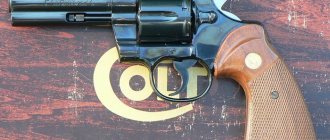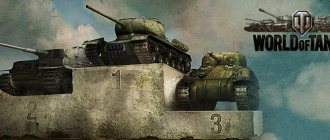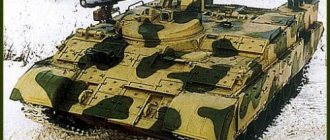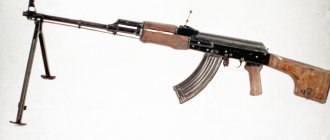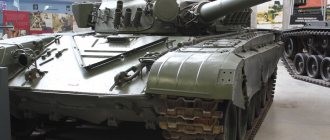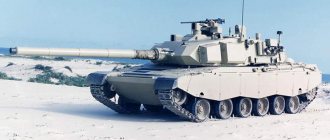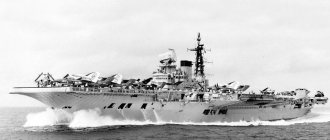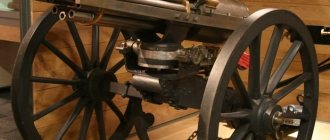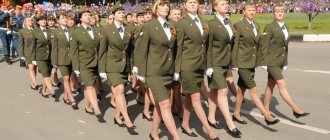The pistol is a short-barreled hand weapon, the main task of which is to fight enemy personnel at a distance of up to 50 meters. The first designs were mostly single-shot, equipped with a rifled or smooth barrel. Now almost all types of pistols are self-loading, the barrels are rifled, and the magazines used contain significant ammunition ranging from 5-20 rounds or even more.
Modern pistols of various types and purposes
Glock 17 (Austria)
Glock 17 (Glock 17) is an Austrian pistol developed by Glock for the needs of the Austrian army. It became the first weapon developed by this company. The resulting model turned out to be quite successful and convenient for use, thanks to which it was later adopted by the Austrian army under the designation P80. Due to its combat qualities and reliability, it has become widespread as a civilian self-defense weapon. Available in various versions for different cartridges (9x19 mm Parabellum, .40 S&W, 10 mm Auto, .357 SIG, .45 ACP and .45 GAP).
A design feature is the absence of a safety box and trigger. The pistol is mostly made of high-strength heat-resistant plastic up to 200 °C. This makes the Glock 17 lightweight and extremely durable. The principle of operation is “snatch and shoot”, there is no safety, but the shot will not occur without fully pressing the “safe action” trigger. Composed of 33 parts, partial disassembly is carried out in seconds
Colt M1911 (USA)
M1911 is a self-loading pistol chambered for . 45 ACP.
Developed by John Moses Browning in 1908 under the name Colt-Browning (US Patent 984519, Feb. 14, 1911). It was in service with the US Armed Forces from 1911 to 1985, and is still authorized for use today. One of the most famous and popular pistols of this company. Widely used and used by the US police and army. It was subsequently modernized and given the name M1911A1 and has been in service ever since without any significant changes. True, the M1911A1 model also exists in a version chambered for .38ACP caliber cartridges.
The automatic pistol operates on the principle of recoil of the barrel with a short stroke. The barrel is connected to the frame using a movable earring, which provides locking and unlocking of the barrel. Under the influence of recoil, the barrel begins to move backward along with the bolt-casing, but the earring, turning on a fixed axis, forces the breech to lower, disengaging the lugs of the barrel from engaging with the grooves on the inner surface of the bolt-casing.
The theory stated that since the barrel began to decline before the bullet left the bore, its movement would adversely affect shooting accuracy, but in reality no one complained about the accuracy of the M1911. Trigger trigger, single action, with open trigger arrangement. The drummer is inertial. It is shorter than the channel in which it moves and is spring-loaded. After hitting the trigger, he goes forward, hits the cartridge primer and immediately hides back into the channel. The pistol has two safeties - an automatic one, which turns off when covered with your hand, and a flag safety device, which blocks the trigger and bolt when turned on.
The return spring is located under the barrel. Open sight. Model M1911A1 (in the picture) differs very slightly. The profile of the rear end of the handle and the shape of the frame safety lever have been changed, and the frame behind the trigger is slightly concave. The trigger shank has also changed (instead of a round head there is a spoke).
Walther P38 (Germany)
The P38 pistol was developed back in the second half of the thirties specifically as an army pistol. Its first user was Sweden, which purchased a small number of Walther HP pistols (Heeres Pistole, that is, army pistol) in 1938; in 1940, under the official designation Pistole 38, it was adopted by the Wehrmacht and was widely used during the Second World War. The production of P38 pistols continued immediately after the end of the war in 1945-46, from military stocks, and was carried out under the supervision of the French occupation authorities. In the mid-1950s, the Carl Walther company began to rise from its post-war ruins.
In 1957, the Bundeswehr adopted the P1 pistol, which differed from the first P38 only in its aluminum frame. At the same time, the commercial version of the same pistol was still called P38. Production of commercial steel frame P38 pistols in the post-war period was fairly small. In 1975, a reinforcing hexagonal cross-section rod was introduced into the design of the P1/P38 pistols, located in a frame in the area where the barrel locking cylinder is located. In the early 1970s, to unify and modernize the very diverse fleet of pistols of the German police, the P4 pistol was developed and approved for use, which was a modification of the P1/P38 pistol with a shortened barrel and a modified safety mechanism. P4 pistols remained in production until 1981, being superseded by the more advanced Walther P5 model.
The best special forces submachine guns
A fighter with an FN P90 submachine gun, photo: fnherstal.com
The first submachine guns appeared during the First World War; for those years it was a real breakthrough. By that time, all participants in the war had already managed to appreciate the importance of machine gun fire and the machine guns themselves, which clearly proved their effectiveness on the battlefields.
The appearance of individual small arms, which could fire automatic pistol cartridges, was the next stage of development. Now any fighter could get his hands on an automatic weapon, while maintaining high mobility and the ability to maneuver fire. Considering that most machine guns of those years were mounted or carriage-mounted and could weigh up to 60 kg, this was obvious progress.
During the Second World War, submachine guns were already widely distributed in the armies of the warring countries; it was a real benefit for such weapons. After the war, the interest of the armies of the world shifted towards machine guns (assault rifles), which became the main individual weapon of a soldier. But submachine guns have not disappeared anywhere. This weapon is now widely used by special forces throughout the world, especially police special forces.
Belgian FN P90 submachine gun
The FN P90 submachine gun stands out for its futuristic design.
This Belgian model of automatic weapons is familiar to many, even those citizens who are not particularly keen on small arms. It's all about a very memorable appearance. The Belgian company FN Herstal has released a model that is difficult to confuse with other models on the market, while at the same time providing the weapon with an excellent set of characteristics. Designers from Belgium invested in the design and made the right decision. The bullpup model is in demand all over the world and is in service with dozens of countries. Turning to the bullpup design allowed the developers to reduce the overall dimensions of the weapon without compromising the barrel and firing characteristics. With a total length of 505 mm, the FN P90 has a barrel length of 264 mm. This is a very worthy indicator.
FN P90 submachine gun, photo: fnherstal.com
The FN P90 uses 5.7x28 mm ammunition as the main cartridge. Belgian samples are made specifically for this cartridge. In addition to its compact size, the weapon is also lightweight. Without cartridges, the model weighs approximately 2.6 kg. The effective firing range of the FN P90 submachine gun is 200 meters. Rate of fire from 850 to 1100 rounds per minute depending on the model.
A distinctive feature of the Belgian submachine gun is its unusual magazine, designed to hold 50 rounds. The store is unique; a patent for it in the United States was issued in March 1990. The box magazine is located on top of the weapon's receiver, and the cartridges in it are located horizontally, perpendicular to the barrel of the submachine gun. They rotate 90 degrees before being fed into the chamber. The magazine is made of transparent plastic, which allows the shooter to always see how many cartridges remain at his disposal.
Uzi submachine guns
When talking about submachine guns, it would be difficult to ignore the Israeli Uzi model.
This is a truly iconic and well-recognized example of small arms, which has become the hero of numerous films, leaving a big mark on popular culture. There is nothing strange in this, considering that various modifications of the Uzi were in service with armies, police special forces and security forces in more than 95 countries around the world. The submachine gun, created by designer Uziel Gal, was named in his honor and has been mass produced since the second half of the 1950s. In Israel, weapons are produced by the large arms concern Israel Military Industries. This is one of the few examples of Israeli weapons that were widely distributed throughout the world, taking part in many wars and conflicts of the second half of the 20th century. In the 21st century, weapons are still relevant.
Israeli army Uzi submachine gun, photo: wikimedia.org
The submachine gun turned out to be compact. Modern Mini-UZI and Micro-Uzi models are truly miniature. Thus, the Mini-UZI model has a total length of 360 mm with the butt folded, and the Micro-Uzi is 250 mm, in this indicator the submachine gun is as close as possible to automatic pistols. Simultaneously with the overall length, the trunk also decreased. For the Micro-Uzi model, the barrel length is only 134 mm. The weight of the models is also appropriate: 2.75 kg and 1.95 kg, respectively.
Of course, Israeli submachine guns cannot boast good accuracy or effective firing range. But in confined spaces, dense buildings or at short distances they are very effective, for which they are often used by police units around the world. The cartridge used is the timeless classic 9x19 mm Parabellum.
Experts call another important advantage of the Uzi submachine guns the method of reloading the weapon when “the hand finds the hand.” The UZI handle also doubles as a mouth for box magazines and is very comfortable to use, especially in the dark. At the same time, shooters have access to a wide variety of magazines with 20, 32, 40, 50 or 62 rounds.
Heckler & Koch MP5 submachine gun
There will be a place in the ranking for two representatives of the German company Heckler & Koch.
Designers from the small town of Oberndorf am Neckar created two models of small arms that were widely distributed throughout the world. Thus, the MP5 submachine gun chambered for the 9x19 mm Parabellum cartridge, created in the early 1960s, was in service with more than 50 states and was widely used by NATO countries. This model was even used by American special forces from the Navy SEALs unit. The weapon turned out to be reliable and durable in German style. The MP5 does not lose its relevance; many police and military special forces are still armed with this particular submachine gun. At the same time, externally the weapon is an adaptation of the G3 assault rifle, which has decreased in size and received a pistol cartridge. The overall shape and configuration of the G3 and MP5 are as close as possible, right down to the adjustable sights.
One of the early versions of the MP5A3 submachine gun, photo: wikimedia.org
The model of the MP5A4 submachine gun with a plastic butt and the ability to fire “with a cut-off” of three cartridges has a total length of 680 mm, the barrel length is 225 mm. The weight of the submachine gun without cartridges is 2.66 kg. Mass models with a folding stock have a maximum length of up to 550 mm.
The target firing range of MP5 submachine guns is 200 meters. Models are equipped mainly with two magazines: 30 and 40 rounds. Experts highlight the good muzzle energy of submachine guns and their low recoil in comparison with small arms with a blowback. Due to firing from a closed bolt, the MP5 achieves high single-fire accuracy.
Heckler & Koch MP7 submachine gun
The second very popular and successful model of the German arms company was the MP7 submachine gun.
The small compact submachine gun, created in the early 2000s, can in some ways be called the answer to the Israeli Uzi, only more advanced and designed at the most modern level. The model is currently actively conquering the market. At the same time, operators are located not only in Europe. Thus, MP7 submachine guns are in service with special forces of South Korea and Japan. It is also interesting that this particular model is in service with the Vatican Swiss Guard.
Despite its small size, the MP7 submachine gun is superior in accuracy to many competitors of the same dimensions. The length of the submachine gun with the butt folded is 415 mm, with the stock unfolded – 638 mm. Barrel length – 180 mm without flash suppressor. The weight of the weapon is also very small - only 1.8 kg without a magazine with cartridges. There are two main types of magazines available to shooters: 20 and 40 rounds, differing in weight (0.1 kg and 0.2 kg, respectively).
MP7A1 submachine gun, photo: wikimedia.org
A distinctive feature of the model is the 4.6x30 mm cartridge. Automatic weapons were specially developed for this new ammunition. Experts call the advantages of this cartridge low recoil when firing, good trajectory flatness, and high shooting accuracy. At the same time, the stopping effect of such ammunition is predictably low.
Like the Uzi, the German submachine gun is configured so that the magazine is inserted into the pistol grip. A folding telescopic stock and an additional front folding handle provide ease of use of the weapon.
Submachine gun "Vityaz"
The domestic submachine gun “Vityaz” closes the rating.
Small arms from Izhevsk are constantly being improved and are presented in different versions. The model received its name from the name of the special forces “Vityaz”, for which the submachine gun was created. Currently, this weapon, designed at Izhmash in the early 2000s, is in service with the Russian Guard, police, FSB, FSIN and other Russian law enforcement agencies. Like the MP5, the Russian submachine gun was based on its older brothers. So, “Vityaz” in Spanish. 10 was based on a shortened version of the Kalashnikov AKS-74U assault rifle. But the “Vityaz” model in Spanish. 20, also known as Vityaz-SN (PP 19-01), was based on the more advanced AK-105 assault rifle. It is reported that the models are unified by at least 70 percent.
Submachine gun "Vityaz-SN", frame: kalashnikov.media
The weight of the Vityaz-SN model is 2.9 kg without ammunition. The length of the weapon with the butt folded is 475 mm, with the stock unfolded – 698 mm. Barrel length – 237 mm. The Russian submachine gun uses the 9x19 mm Parabellum cartridge, which is widespread throughout the world, as ammunition. The principle of firing from a closed bolt implemented in the PP 19-01 submachine gun ensures high accuracy of hits.
Possessing a standard target firing range of 200 meters for such weapons, the Russian submachine gun has a firing mechanism that allows automatic and single firing. "Vityaz" is equipped with box magazines for 30 rounds. The technical rate of fire of the model is up to 800 rounds per minute.
Luger P08 (Germany)
Georg Luger created the world famous Parabellum around 1898, based on the cartridge and locking system designed by Hugo Borchardt. Luger modified the Borchardt lever locking system to make it more compact. Already in 1900-1902, Switzerland adopted Parabellum Model 1900 7.65mm caliber into service with its army. A little later, Georg Luger, together with the DWM company (the main manufacturer of Parabellums in the first quarter of the twentieth century), redesigned his cartridge for a 9mm caliber bullet, and the most popular pistol cartridge in the world, 9x19mm Luger/Parabellum, was born. In 1904, the 9mm parabellum was adopted by the German Navy, and in 1908 by the German Army. Subsequently, Lugers were in service in many countries around the world, and were in service at least until the 1950s.
The Parabellum pistol (the name comes from the Latin proverb Si vis pacem, Para bellum - If you want peace, prepare for war), is a self-loading pistol with a single-action striker trigger. The pistol is built according to a scheme with a short barrel stroke and locking with a lever system. In the locked position, the levers are in the “dead center” position, rigidly fixing the bolt in the movable receiver connected to the barrel. When the entire system of levers moves back under the influence of recoil after a shot, the levers with their central axis are located on the protrusion of the spito frame, which forces them to pass the “dead point” and “fold” upward, unlocking the barrel and allowing the bolt to go back. Lugers were produced with a variety of barrel lengths - from 98 mm to 203 mm (artillery model) and more. They were also produced in a "carbine" version, with a long barrel, a removable wooden fore-end and a detachable butt. Some (early) models were equipped with an automatic safety on the back of the handle.
In general, the Parabellums were distinguished by a very comfortable handle, providing a comfortable grip and convenient aiming, and good shooting accuracy. However, they were difficult (and therefore expensive) to produce, and very sensitive to contamination.
TT (USSR)
The TT (Tula, Tokarev) pistol, as its name suggests, was developed at the Tula Arms Factory by the legendary Russian gunsmith Fedor Tokarev. The development of a new self-loading pistol, designed to replace both the standard outdated Nagan revolver model 1895, and various imported pistols in service with the Red Army, began in the second half of the 1920s. In 1930, after extensive testing, the Tokarev system pistol was recommended for adoption, and the army ordered several thousand pistols for military testing.
Pistol TT arr. For 33 years it was produced in parallel with the Nagan revolver until the beginning of the Great Patriotic War, and then completely replaced the Nagan from production. In the USSR, production of the TT continued until 1952, when it was officially replaced in the arsenal of the Soviet Army by the PM pistol of the Makarov system. The TT remained in service with the troops until the 1960s, and to this day a significant number are mothballed in army reserve warehouses. In total, approximately 1,700,000 TT pistols were produced in the USSR.
In China and Yugoslavia, TT-based pistols are still produced.
For its time, the TT pistol was a fairly advanced weapon, powerful and reliable, easy to maintain and repair. Its main disadvantages were reduced safety in handling due to the lack of full-fledged safety devices, the relatively low stopping effect of a light 7.62mm bullet, and the not very comfortable shape of the handle.
Tokarev model 1933 is built on the basis of automation, using recoil energy with a short barrel stroke. The barrel is locked by tilting it in a vertical plane using a swinging earring (similar to the Browning / Colt M1911 system). The locking lugs on the barrel are made along its entire circumference, which simplifies the manufacture of the barrel. The trigger mechanism is a hammer, single action, made in the form of a single easily removable module (for the first time in the world). There are no safety devices; for relatively safe carrying of a pistol with a cartridge in the chamber, there was a safety half-cocked trigger, however, if the trigger parts were worn out, dropping the pistol with the hammer half-cocked could lead to an accidental shot.
Browning "High-Power"
0
Another famous creation of the brilliant Browning was the brother of the Colt M1911, the Browning High-Power (HP). They say that death overtook the designer (John Browning died of a heart attack) at his workbench when he was “sawing” this particular pistol. After creating the M1911, Browning worked on a pistol for the French army. Due to patent restrictions, he couldn't simply copy the M1911, so the Hi-Power design had some changes compared to the Colt. Nevertheless, both pistols are made according to the same design and are similar both externally and structurally. After the death of John Browning, his colleague Didier Savon, chief designer of the FN company, completed work on the pistol. It was he who developed a 13-round magazine for the new Browning, which is why the 1935 model Browning received the nickname High-Power - “great power.” In addition to some technical details, the main differences between the Browning HP and the Colt M1911 was the use of the successful Luger 9x19 para cartridge, thanks to which the HP was slightly smaller and lighter than its progenitor. Now we can say with confidence that it was with the advent of the 1935 model Browning that the formation of the appearance of the modern pistol was completed. And currently, most full-size army and police pistols are made according to the Browning design, chambered for 9x19 para and have a large-capacity magazine. Characteristics Weight - 0.885 kg uncharged. Length - 200 mm. Caliber - 38 (9 mm). Magazine capacity - 13 rounds. The initial bullet speed is 350 m/s. "High-Powers", like Colts, were produced in huge quantities (more than 1 million units in total) by various factories on both sides of the ocean. Moreover, both the Allies and the Axis countries were armed with pistols. For the Wehrmacht, HP were produced in occupied Belgium directly at the FN plant. The Browning Model 1935 was the weapon of choice for commandos on both sides for its reliability, convenience, and large magazine capacity. Among the soldiers of the Red Army, Brownings were very rare and were highly valued for their reliability and quality.
0
Despite the emergence of new types of weapons made of composite materials, many countries still prefer time-tested steel models. Currently, the Browning HP, like the Colt M1911, is one of the best-selling and commercially successful weapon models.
Mauser C-96 (Germany)
Mauser K96 (German: Mauser C96 from Construktion 96) is a German self-loading pistol developed in 1895.
The pistol was developed by the brothers Fidel, Friedrich and Josef Feederle. Fidel Federle was in charge of the experimental weapons workshop (Waffenfabrik Mauser), and the new one was initially called the P-7.63 or Federle pistol. Subsequently, the pistol was patented in the name of Paul Mauser in Germany in 1895 (German Reichspatent No. 90430 dated September 11, 1895), in Great Britain in 1896.
The first pistols were manufactured in 1896, and mass production began in 1897[4], which continued until 1939. During this time, more than a million C96 pistols were produced.
One of the reasons why the Mauser became popular was its enormous, at that time, power. The pistol was positioned as a light carbine, which in essence it was: a wooden holster was used as a butt, and the destructive power of the bullet was claimed to be at a range of up to 1000 m (however, the horizontal spread of bullets for a stationary pistol could be several meters, so precision shooting at such a range was out of the question).
The second reason is that the considerable cost of such weapons gave the owner greater weight both in self-esteem and in society.
Things from days gone by
Miniature copies of muskets became widespread in the 15th century AD. According to available information, the trendsetters were Italians (from the city of Pistoia, which is an additional argument), but this is only one of the versions.
Most likely, they simply put production on stream. But, in any case, soon the brilliant French nobles began to actively shoot their rivals in the boudoir of Parisian beauties.
D'Artagnan's ancestors borrowed this innovation from German mercenaries captured by the troops of Henry II in the battle with Italian troops at Ranti in 1554.
At that time, the weapon was equipped with a wick fuse (or lock), and although it was more comfortable to carry, it did not load much faster.
https://www.youtube.com/watch?v=pV0CalRL-Z4&t=13s
Most often, pistols were used by cavalrymen; holsters with loaded pistols were hung from the saddle.
Pistol Heckler Koch HK 45 (Germany)
The Heckler Koch HK 45 pistol was originally developed for the new combat pistol competition for the US Army. This competition was announced in 2005-2006, but never took place for a number of political reasons, and the one developed for it in 2007 was introduced to the US civilian and police arms markets under the symbol HK 45. The new pistol inherited the time-tested, reliable design of pistols Heckler-Koch USP combined with the popular .45 (11.43mm) cartridge in the USA and improved ergonomics. Based on the full-size version of the NK 45, a shortened (compact) version of the HK 45C pistol has also been developed, using slightly shorter, smaller-capacity magazines from the Heckler-Koch USP 45 Compact pistols.
The Heckler Koch HK 45 pistol uses a modified Browning pistol automatic circuit using the recoil energy of the barrel during its short stroke. The barrel is connected to the bolt by a massive protrusion in the breech of the barrel with a window for ejecting cartridges on the bolt. The reduction of the barrel when disengaged from the bolt occurs when the shaped tide under the barrel interacts with an inclined groove made in the rear part of the return spring guide rod. A polymer recoil buffer has been introduced into the design of the return mechanism, which reduces the load on the plastic frame and reduces the recoil felt by the shooter. The trigger mechanism is hammer-operated, modular, and can be supplied in one of 10 basic options typical of the Heckler-Koch USP line, including options with self-cocking or only self-cocking trigger. The pistol has double-sided slide stop levers and magazine latches with improved ergonomics compared to its predecessors; variants with a manual safety also have improved safety levers on the frame. Another improvement in terms of ergonomics is the reshaped handle with interchangeable butt pads (each comes with 3 standard sizes of butt pads). The sights are non-adjustable, with white contrasting inserts. On the frame under the barrel there is a Picatinny rail type guide for installing a combat flashlight or laser laser.
Next step
In the 16th century, the inconvenient and dangerous wick was replaced by a wheel mechanism (according to legend, Leonardo Da Vinci himself had a hand in creating such mechanisms). The structure was started using a key.
This made it possible to avoid misfires, but complicated the loading process. Despite the simplification of the design over time, wheel locks remained extremely complex and expensive to manufacture, therefore, despite their reliability, they gradually gave way to other methods of ignition.
It is worth noting that some of the pistols already at that time acquired the semblance of unitary cartridges; it was not the pistols themselves that were charged, but separately inserted charging chambers; to reload such a pistol, you only had to change the chamber and cock the mechanism with a key.
In the 17th century, the wheeled mechanism was replaced by a flintlock mechanism, the essence of which was the hammer hitting the flint in the lock.
The carved spark ignited the gunpowder fuse in the breech (to be fair, such a mechanism was originally tested on guns). The pistols were, naturally, smoothbore. Although there were also rifled ones, in this case they were made by masters, and therefore extremely rare.
Already at the beginning of the 19th century, a capsule, a cap with a flammable composition, appeared. In view of this, the flintlock mechanism left the scene, since ignition using a primer was more convenient and faster. Initially smooth-bore, with the development of industry, pistols also received rifled barrels, which made it possible to improve the accuracy of the battle and increase the effective firing range.
Since the mid-twentieth century, weapons - pistols and revolvers - have taken another step towards increasing the rate of fire and multiple charges.
SIG-Sauer P228 (Germany, Switzerland)
The P228 pistol was released in 1989, its production was established in Germany at the JP Sauer & Sohns plant. The P228 pistol was created as a compact version of the P226 pistol, more suitable for everyday carry. The pistol owes its creation to the American competition for the XM11 compact army pistol, since the P225 pistol initially presented for this competition did not satisfy the Americans due to the relatively small magazine capacity. The pistol completely inherited the design of the P226, but received a shortened barrel and bolt, as well as a handle that accommodated a double-row magazine with a capacity of 13 (instead of 15) rounds. The pistol turned out to be extremely successful, and is widely used by various law enforcement agencies around the world, and is also successfully sold on the civilian market. P228 pistols, as well as a reinforced version, P229, are used by the FBI, the Drug Enforcement Agency and the US Secret Service. The P228 is also in service in the United States as a personal self-defense weapon for certain categories of military personnel under the designation M11.
OTs-27 "Berdysh"
Stechkin made the best pistols in Russia for a long time, and many have reached this day. For example, the famous “Berdysh”, which entered service with the Ministry of Internal Affairs in 2002. The weapon was made of steel, the barrel was quick-detachable, and this was done only so that its owner could change the caliber in a short period of time. The OTs-27 is capable of using 7.62 mm or 9 mm caliber cartridges. Such powerful pistols in Russia 2021 have a spacious magazine, several sight options and are easy to maintain.
- Year of creation: 2002
- Caliber: 9 and 7.62 mm.
- Length: 200 mm.
- Bullet speed: 320 m/s
- Effective range: 50m
- Magazine: 18 rounds
- Weight: 930 g
Fabrique Nationale (FN) Five-seveN (Belgium)
The Five-Seven pistol (that's right, not Five-Seven!) was developed by the Belgian company Fabrique National, Gerstal, as a companion weapon for the P90 submachine gun of the same company. Key features of both the Five-Seven and the P90 are the new, specially developed SS190 5.7mm cartridge with a pointed bullet that produces a muzzle velocity of over 650 m/s when fired from the Five-Seven and approximately 700 m/s when fired from the P90. The main task of such weapons is to fight an enemy protected by body armor.
The Five-Seven pistol is built according to a semi-blowback design, and has a polymer frame with guides located under the barrel for attaching a tactical flashlight or laser designator. The trigger mechanism is striker-fired, with an integrated firing pin lock until the trigger is fully pressed. Currently, Five-seveN is available in two versions: standard, with only a double-action trigger, without a non-automatic safety, and Tactical - with a single-action trigger, with a double-sided manual safety located on the frame above the trigger guard.
The standard Five-seveN variant is intended primarily for the military as a weapon of last chance, while the Tactical variant is intended for the police, where a pistol is often the main weapon. A shorter trigger stroke with less trigger force ensures more accurate shooting.
Beretta 93R (Italy)
The Beretta 93R automatic pistol was developed in the mid-1970s based on the newly created Beretta 92 semi-automatic pistol. The "93R" designation designates a 9mm pistol, 3rd model, with the ability to fire bursts (Raffica). The Beretta 93R pistol was intended to arm various special police and carabinieri units, that is, those who need maximum firepower in short-term contacts at short and ultra-short ranges. The pistol entered service with such elite law enforcement units in Italy as Carabineri GIS and NOCS. Due to the low popularity of the class of automatic pistols, and the emergence of cheaper and no less effective compact submachine guns (Micro-UZI, Steyr TMP, HK MP5K, etc.), the production of Beretta 93R pistols has been completed.
Stechkin automatic pistol - APS (USSR/Russia)
The APS pistol was developed in the late 1940s - early 1950s by designer I. Ya. Stechkin and adopted by the Soviet Army in 1951, simultaneously with the Makarov PM pistol. APS (Automatic Pistol Stechkin) was intended as a personal self-defense weapon for certain categories of military personnel and officers who were not entitled to a Kalashnikov assault rifle or SKS carbine, and the Makarov pistol seemed insufficient. These included, for example, tank and combat vehicle crews, gun crews, grenade launchers, and officers operating in an active combat zone. Compared to the PM, the APS provided significantly greater firepower and combat effectiveness due to its larger magazine capacity and longer barrel. In addition, to increase shooting accuracy, a holster was attached - a butt attached to the handle. If necessary, it was also possible to fire bursts from the APS, and thanks to the presence of a retarder, the rate of fire remained more or less controllable. Despite these advantages, the APS, especially in combination with a standard holster-butt, was too bulky and heavy; it interfered with the emergency exit of military equipment, and as a result, it was soon removed from service with the SA and sent to reserve storage.
With the rise in crime in the early 1990s, Russian law enforcement forces discovered. that the standard PM pistol has insufficient combat effectiveness, and army Kalashnikov assault rifles are often overpowered. The best solution could be submachine guns, but they were not yet in mass production, and therefore various riot police units, special forces and others began to purchase decommissioned from the army, but fully capable APS. Even now, in 2003, when there are various submachine guns and more powerful pistols of the latest systems, many representatives of the “authorities” still prefer Stechkins for their cheapness, wide availability of cartridges, and fairly good combat characteristics
Pistols and revolvers
The desire for speed of fire led to the creation of the revolver. The first samples were created back in the 16th century. The essence of the invention was the use of a rotating (translation of the word revolver) drum with charges.
But, in the presence of a flintlock, it was cumbersome and had the same problem with the constant addition of gunpowder to a special shelf to ignite the main charge and did not provide continuous firing.
The time of revolvers came in the 19th century.
At the beginning of the century, officer Artemas Wheeler from the United States officially documents the invention of a pistol with a cylinder and a percussion flintlock. A little later, the Englishman Collier presented an improved model in London.
The presence of a powerful spring in the form of a plate (a prototype of a mainspring) pushed the drum tightly and prevented breakthroughs of powder gases. A gun with a similar reloading mechanism was also presented.
This weapon was interesting, but too expensive and did not become widespread in Europe.
However, the design features were taken into account by gun specialists.
With the invention of the capsule, which ensures relatively continuous firing and machine-tool production of weapon components, which significantly simplifies and reduces the cost of work.
In 1836, a certain Mr. Pearson sold the invention of a pistol with a revolving mechanism for feeding cartridges to Colonel S. Colt in the same USA. Samuel established the mass production of capsule revolvers, known today as the Colt “Peacemaker,” and will forever remain in the memory of grateful humanity.
Soon American revolvers replaced similar single-shot types of weapons throughout the world. In the modern United States, there is a proverb about this: “God created people as they are, and only Colonel Colt made them equal.”
Makarov pistol PM / PMM / IZH-71 (USSR/Russia)
The 9-mm Makarov pistol (PM, GRAU Index - 56-A-125) is a self-loading pistol developed by Soviet designer Nikolai Fedorovich Makarov in 1948. Adopted into service in 1951. It is a personal weapon in the Soviet and post-Soviet armed forces and law enforcement agencies.
In 1947-1948, a competition was held in the USSR for a new compact pistol for the senior command staff of the Soviet Army. The TT pistol, and even more so the Nagant revolver, were considered obsolete models. In addition, it was decided to introduce two pistols into the army: a long-barreled automatic pistol for line officers (this became the Stechkin automatic pistol) and a small-sized pistol for senior officers and as a “peacetime weapon.” According to the terms of the competition, it was necessary to create a pistol with a blowback bolt and a self-cocking firing mechanism. As a starting point, designers were offered the well-proven Walther PP, produced since 1929. Initially, it was required to submit two samples - in calibers 7.65 mm and 9 mm, later they settled on the newly created 9 mm cartridge 9x18 mm PM, more powerful (bullet energy 300 J) than the 9x17 mm cartridge, which was used in "Walter PP". A bullet from such a cartridge has a better stopping effect than a bullet from the 7.62x25 mm TT cartridge, despite its lower power. The moderate power of the cartridge allows the use of a fixed-barrel blowback design.
Cartridge
Revolving cartridges are distinguished by the presence of a rim, and, as a rule, by increased power, since placement in the chambers of a drum, without the presence of moving parts, limits the strength of the designer less. But now these lines are blurring, revolvers can be designed for a pistol cartridge, but in this case the cylinder requires more complexity to securely fix the cartridge in the chamber.
Pistol cartridges may differ in design, such as a hidden flange or a semi-protruding one, the fact is that flangeless cartridges are more suitable for use in box magazines. But at the same time, unlike revolver cartridges, the power of a pistol cartridge cannot be increased unnecessarily; this will lead to rapid wear of the rubbing parts of the pistol.
The most famous pistol cartridges are used - the iconic US pistol - Colt M1911, 11.43 mm cartridge, M9 pistol, 9 mm Para Luger cartridge, 9x18 mm PM cartridge.
Pistol Yarygin PYA (MR-443 “Rook”) (Russia)
The Yarygin pistol (PYa “Grach”, GRAU Index - 6P35) is a Russian-made self-loading pistol. Developed by a team of designers under the leadership of V. A. Yarygin, mass-produced at the Izhevsk Mechanical Plant.
In 1990, the USSR Ministry of Defense announced a competition for a new pistol, designed to replace the PM pistol, which was in service but did not fully meet modern requirements (R&D program "Grach"). In 1993, a pistol designed by Yarygin was presented to this competition. According to the test results, in 2000 the pistol (named MP-443 “Rook”) became the winner of the competition. In 2003, under the name “9-mm Yarygin pistol” (YA), it was adopted by the Armed Forces of the Russian Federation.
As of the beginning of 2010, Yarygin pistols began to enter service with units of the Russian Armed Forces, internal troops, special units of the Ministry of Internal Affairs of the Russian Federation and other law enforcement agencies.
In 2011, mass production of PYa for the Russian Army was launched. In 2012, officers of the Western Military District began to master the Yarygin as a new standard weapon.
PSM
The best pistols in Russia should not only be of high quality, but also comfortable. PSM is one of these, because it has compact dimensions, small dimensions, and therefore is used in serious military structures. The invention was put into production at the Izhevsk plant in 1972 and does not leave the assembly line to this day. Russian PSM pistols are convenient to use during operations, because they are ideal for concealed carry. It is used in a number of other state armies that were previously part of the USSR.
- Year of creation: 1972
- Caliber: 5.45 mm.
- Length: 155 mm.
- Bullet speed: 315 m/s
- Effective range: 25 m
- Magazine: 8 rounds
- Weight: 460 g
Pistol Heckler-Koch USP (Germany)
Heckler&Koch USP is a self-loading pistol developed by the German company Heckler & Koch. First introduced in 1993. Designed to arm the police and army. The HK USP is currently available in .40 S&W, 9x19mm Parabellum and .45 ACP cartridges. In general, USP series pistols are distinguished by the highest reliability and survivability, and good shooting accuracy. Minor disadvantages include the significant size of the weapon, even in the compact version, a rather high center of gravity and a massive bolt, which makes concealed carry somewhat difficult.
Work on creating a new promising pistol, primarily intended for the American market (both civilian and police), was started by the armory in mid-1989. It was envisaged to develop a fairly universal weapon that would have various trigger options and would meet the requirements of various customers, as well as high characteristics. The name of the new weapon, USP, stood for Universal Selbstlade Pistole, that is, universal self-loading. The creation of the new weapon was led by Helmut Weldle. The new pistol was immediately designed for the American .40 S&W cartridge, and the release of a 9 mm modification was planned by installing a different barrel and magazine into the basic .40 caliber model. Serial production of the first version of USP was launched in 1993.
Lebedev pistol PL-15
The best pistol in Russia today , which is actively being introduced into the country’s army. For the first time it could be seen at the Army 2016 forum, where the Kalashnikov concern presented it to everyone. When developing weapons, the experience of the largest companies is taken into account; the military should receive one of the best guns in the world. The most powerful pistol in Russia will also be reliable; according to representatives, it will turn out to be almost the best in terms of durability, and is also good in range. Owners will be able to use any powerful ammunition along with the submarine and rest assured that even severe northern frosts will not affect the bullet’s flight in any way. A spontaneous shot from it is simply impossible and the manufacturers have done everything possible for this. such best pistols in Russia 2021 in the future; you will especially like the cool modern design, which has no analogues.
- Year of creation: 2016
- Caliber: 9 mm.
- Length: 205 mm.
- Effective range: 100m
- Magazine: 16 rounds
- Weight: 800 g
(Visited 6,473 times, 13 visits today)
Nagan system revolver
Revolver of the Nagant system, Nagant - a revolver developed by the Belgian gunsmiths brothers Emile (Émile) (1830-1902) and Leon (Léon) (1833-1900) Nagant, which was in service and produced in a number of countries in the late 19th - mid-20th century.
In the last quarter of the 19th century, many states began to think about rearmament of their armies. By that time, the most promising examples of personal short-barreled firearms were revolvers, which combined sufficient simplicity of design, multiple charges and reliability. The Belgian city of Liege was one of the European centers of the arms industry. Since 1859, there was the Emile and Leon Nagant Arms Factory (Fabrique d'armes Emile et Léon Nagant) - a small family workshop that repaired Dutch revolvers and designed its own firearms. The first revolver of the original design was presented by the elder brother Emil for testing to the Belgian military department, and it was adopted as an officer and non-commissioned officer weapon under the name “revolver model 1878”
